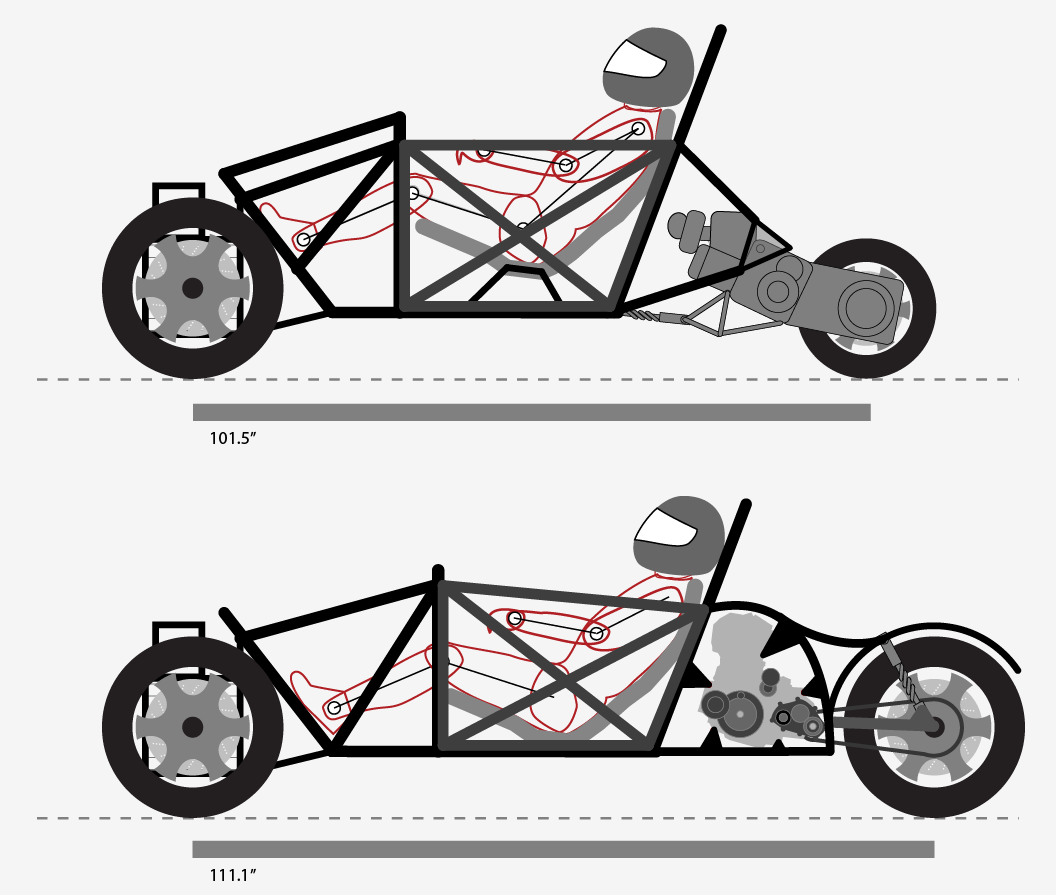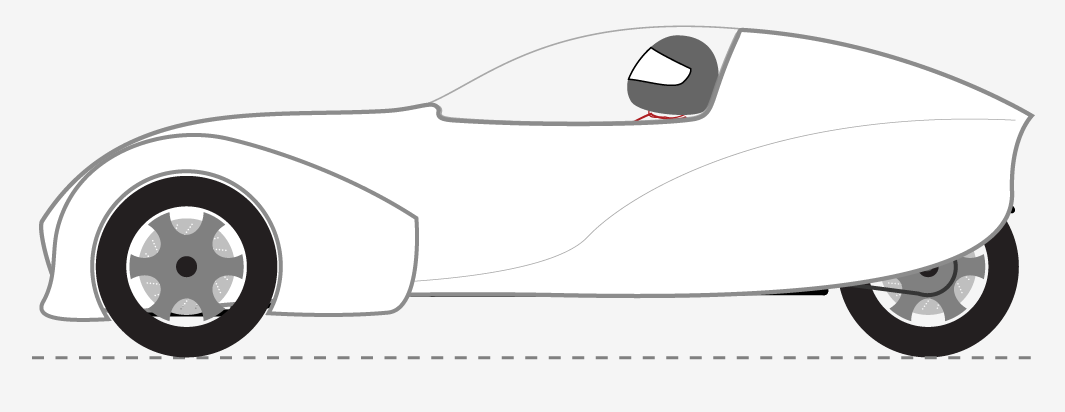So the seed planted by Aaron to use ATV drivetrain is growing into something cool. On twitter, @blalor suggested Honda’s line of TRX sport ATVs. They’re 2WD, chain-driven, EFI, and possibly perfect. I keep eyeing the 400 and 700 models. Both are single-cylinder “thumper” motors with a wide bore and thereby tons of available low-end torque — which will come in handy once I gear it up. I wish Honda were more forthcoming with horsepower numbers, but I’m not finding any. That’s but a detail at this point though.
This ATV setup lets me do a couple things. It lets me run a larger motorcycle wheel and tire on the rear. That gives me higher gearing than both the scooter drivetrain and the original ATV setup by default. Rear sprockets are very easy to change, and this gives me lots of latitude in adjusting the final gear ratio of the drivetrain without touching the actual transmission. Reading up on the TRX specifically, there are aftermarket solutions for high performance exhausts and apparently it’s pretty straightforward to re-map the EFI. That should let me tune a “butter zone” where the motor is at it’s most powerful in its high ranges and it’s most efficient in its low ranges. That way under acceleration, I’ve got plenty of power, but while cruising, it should just bump over and sip fuel. What could be even sweeter is if I could set up a switcher box of some sort that would let me pick between two EFI maps on the fly. One for power, the other for efficiency.
One thing I was very curious about was how the chassis would need to change in order to incorporate a separate engine and rear swing arm. One of the simple beauties of using a scooter drivetrain is that the engine, transmission and rear suspension are all basically one big piece. This is simple, but it isn’t automatically light and there’s no reverse gear option. So what happens when I swap out for an ATV/motorcycle rear end?
I found some reference images of the TRX700xx powerplant and rendered up a quick cross-section. This image compares the original concept Suzuki Bergman powerplant with the TRX. Everything is approximate, of course. The other key shift in this rendering is that I dropped the seat height basically to the floor. This to decrease the forward cross-section that much more. The trade-off is adding about 10″ to the wheelbase between the two changes. This puts the length at about 3″ longer than the wheelbase of BMW 3-series coupe. Not bad, considering it’ll present about 1/3rd the frontal area.
The next question was obviously what does this do to the body shape? Making the hood line lower and the tail longer did some neat things for the side shape of the body. I especially like how that big wheel looks in the rear. The overall effect is really slick. I can’t wait to model this in foam or pine and see what it looks like in 3D. More to come.


Very nice. The rear reminds me a bit of the Z4 coupé.
One thing I hadn’t considered before is that any street-legal scooter or motorcycle will already have had emissions taken into consideration. The EPA’s been cracking down on ATVs (and other OHVs), but I don’t know that they’re subjected to the same levels of emissions that other vehicles on the road are…
Oh, and I’d forgotten about the hi/low switch on the final drive. That could be an interesting twist.
And speaking of “twist”, the ATV drivetrain has an inherent 3rd limb in play: the shifter. I haven’t followed this project closely thus far, I’m sorry to admit. Have you made a provision for any foot-actuated controls? Scooters get by nicely with just three hand controls, but ATVs and motorcycles with clutches typically use both feet and both hands.
The simplicity of the scooter controls was a big part of why this has been a scooter project from the get go. But that was also before I started riding a proper motorcycle. I’m all too familiar with the traditional motorcycle controls now. I’m very comfortable with the idea of a foot shifter and hand clutch on this thing. Even the right foot brake and right hand brake — just go all the way on motorcycle setup. There’s one thing you probably aren’t aware of, since you’re new to the project and that’s the tilt lock. I’ll be using a foot pedal or some other control to actuate an additional hydraulic brake that gives me on-demand tilt lock. That way I can roll up to stop signs and do other slow speed maneuvering without falling over. With scooter controls, having just a single foot pedal for the tilt lock is pretty straightforward. With traditional motorcycle controls, however, it gets more complicated. I’m thinking a rocker-pedal on the rear brake pedal (right foot). Something akin to the wheel brake controls on an airplane where you rock the rudder pedals forward to actuate the wheel brakes. I figure that I’ll need it most when stopping, so there you go.
As for emissions, if I stick to EFI, I should be good. Furthermore, these Honda ATVs appear to share a lot of parts with Honda motorcycles and dirt bikes. On most bikes, the catalytic converters are built into the mufflers. So a simple pipe swap might be enough to pass any emissions test I’d have to take. Thing is though, that also varies by state. Here in Minnesota it might not be an issue. I have yet to gather any info on what it takes to get a custom motorcycle registered here in Minnesota. I imagine there is some manner of inspection. I’ll get that information before I actually build anything and make sure I don’t wind up with something that’ll never be road legal.
Also, I’d thought about the hi/low transaxle too. I’m thinking that the low speed could be perfect for stop and go and low speed ’round town stuff. Then the high gearing would be perfect for the higher speed, higher mpg runs on highways or longer cruises on uninterrupted roads and byways. I’ve never owned an ATV, but I do worry about the long haul durability of the drivetrain. I can’t decide if the short burst nature of ATV riding would mean it was more or less durable than the extended demands of a motorcycle or scooter drivetrain. Does anybody have a 100,000 mile ATV out there somewhere?
Question on the engine placement because I am ignorant.. Is it possible or desirable to rotate the engine 30 or 40 degrees clockwise (in your image above) to shorten up the wheelbase by a bit? I would imagine it would slightly raise the center of gravity, but I doubt it would matter much since everything is so low already.
That’s not a dumb question at all, Steve. The engine as seen in this mockup is already rotated quite a bit as compared to the stock orientation in the ATV. As for center of gravity, it’s counter-intuitive but you don’t actually want the center of gravity on a tilting vehicle to be too low. The whole idea of the lean is to get the center of gravity toward the inside of the turn. If the CG is too low, when the vehicle leans over, that could actually push the CG to the outside of the turn and topple the vehicle. That’s an extreme example, but unlike a car, low center of gravity isn’t the automatic plus to handling stability.
As for length, if I wanted to shorten the wheelbase by a few inches, it’d be much easier and more prudent to raise the seat base or take a more upright seating position. The length isn’t that bad though. Most cabin motorcycles like the Monotracer are even longer than what I’ve got drawn up here and are perfectly maneuverable. Because I’m able to lock the tilt and drive the vehicle flat at low speeds, it ought to be as maneuverable as any small car in a parking lot or other tight space. I’m not particularly concerned with this thing being small. It’s not like a Smart Car where half the idea is to try to cram three of them into a standard parking space. A little bit of length is a good thing, as it’ll make it both more stable at high speeds, but more comfortable over bumps and such.
Last comment for now. I think you’ll find that the 400 engine is plenty for what you’re doing. There is a highly modded Suzuki Burgman on Eco-Modder that gets very high mpg (~75mpg I think). He runs 75mph on the highway every day and among his modifications were a swap to 250 pistons and carb, and even then he runs in “high” gear almost all the time on his custom 2-speed CVT. Also, the Auto X-Prize looks like its been won (though not crowned yet) by a turbo-charged 125cc motorcycle engine in an 800lb 4-passenger vehicle. With that setup they are able to accelerate 0-60 in under 12 second and maintain highway speed without a problem.
I don’t know how much weight or size you’d save with the 400 compared to the 700, they are probably very similar in fact. But if you’re concerned with mpg at all, the 400 is definately the right choice. Even with hypermiling techniques, the eco-modding Burgman rider found that displacement was the limiting factor in improving mileage and so has bee downsizing his 400 engine to improve his efficiency.
I think what Steve meant is to move the engine *above* the rear wheel, thus bringing the rear wheel closer to the seat. This would require separating the engine from the transmission, since the transmission needs to be close to the swingarm pivot. You could connect them with a longer belt or chain.
I’m pretty sure that they share a common casing, so separating the engine from the tranny is no small thing. I really want this thing to be as bolt-on as possible to minimize the amount of actual engineering needed to get the results I’m after. To a point, length is good. It will mean stability and visibility. Even if the wheelbase were shrunk, an appropriately aerodynamic tail would likely extend well beyond the rear wheel anyway.